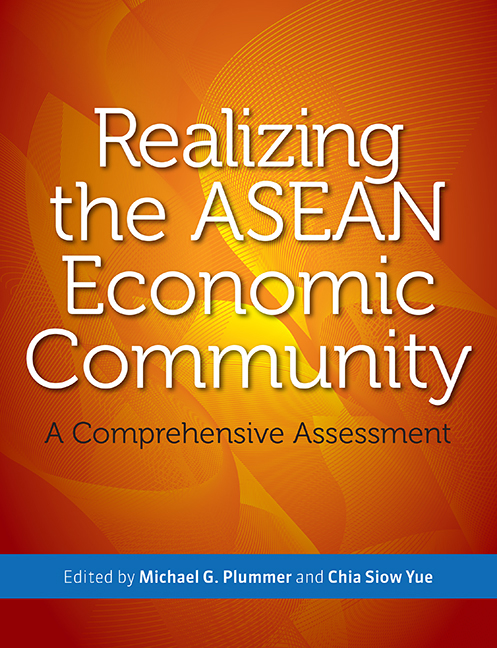Book contents
- Frontmatter
- Contents
- Illustrations
- Foreword
- Executive Summary
- Acknowledgements
- About the Contributors
- 1 Introduction
- 2 Regional Market for Goods, Services, and Skilled Labor
- 3 Competition Policy, Infrastructure, and Intellectual Property Rights
- 4 The AEC and Investment and Capital Flows
- 5 Narrowing the Development Gap in ASEAN
- 6 Competitiveness and Leverage
- 7 Benefits of the AEC
- References
- Appendix A AEC Components
- Appendix B The CGE Model
- Appendix C Developments in Logistics and Aviation
- Appendix D AEC Blueprint Excerpt
- Appendix E ASEAN Free Trade Agreements
- Appendix F ASEAN Member States' Free Trade Agreements
- Appendix G ASEAN Imports and Exports, 2000 and 2006
- Index
Executive Summary
Published online by Cambridge University Press: 21 October 2015
- Frontmatter
- Contents
- Illustrations
- Foreword
- Executive Summary
- Acknowledgements
- About the Contributors
- 1 Introduction
- 2 Regional Market for Goods, Services, and Skilled Labor
- 3 Competition Policy, Infrastructure, and Intellectual Property Rights
- 4 The AEC and Investment and Capital Flows
- 5 Narrowing the Development Gap in ASEAN
- 6 Competitiveness and Leverage
- 7 Benefits of the AEC
- References
- Appendix A AEC Components
- Appendix B The CGE Model
- Appendix C Developments in Logistics and Aviation
- Appendix D AEC Blueprint Excerpt
- Appendix E ASEAN Free Trade Agreements
- Appendix F ASEAN Member States' Free Trade Agreements
- Appendix G ASEAN Imports and Exports, 2000 and 2006
- Index
Summary
The global economy and Asia in particular constantly produce challenges and opportunities for ASEAN and its member states. ASEAN economies must respond to the exigencies of the international marketplace; compete intensively for markets, investments and resources; adapt to the economic rise of China and India; and develop competitiveness and economic vigor sufficient to weather global economic shocks — a need underscored by the current global economic crisis. Greater economic cooperation and integration can help ASEAN Member States meet these challenges and seize opportunities as they emerge. In this regard, the ASEAN Economic Community (AEC) is a bold step in economic reform. As envisaged it is comprised of four parts:
A single market and production base, characterized by a free flow of goods, services, investment, and skilled labor, as well as a freer flow of capital.
A competitive economic region, characterized by sound competition policy, consumer protection, intellectual property rights protection, infrastructure development, sectoral competition in energy and mining, rationalized taxation, and e-commerce.
Equitable economic development, characterized by SME development and enhancement of the Initiative for ASEAN Integration.
Integration into the global economy, with ASEAN centrality and participation in global supply networks.
The creation of a single market and production base should allow ASEAN to benefit from efficiency and economies of scale in value-chain processes, while other aspects of the AEC will boost competitiveness, strengthen ASEAN's institutions, and improve the region's socioeconomic environment. ASEAN Member States intend to complete the AEC by 2015; meeting that deadline will require support at all levels and recognition that implementation will face opposition in some quarters. Securing support, assuaging stakeholders’ concerns, and countering opposition, in turn, requires understanding the full implications of the AEC for ASEAN and ASEAN Member States.
ECONOMIC BENEFITS
Applying a computational general equilibrium (CGE) model under several scenarios, we estimate that ASEAN economic welfare should rise by 5.3 percent, or $69 billion, relative to the baseline — more than six times the effect estimated for AFTA, even under conservative assumptions.
- Type
- Chapter
- Information
- Realizing the ASEAN Economic CommunityA Comprehensive Assessment, pp. xv - xviiiPublisher: ISEAS–Yusof Ishak InstitutePrint publication year: 2009

